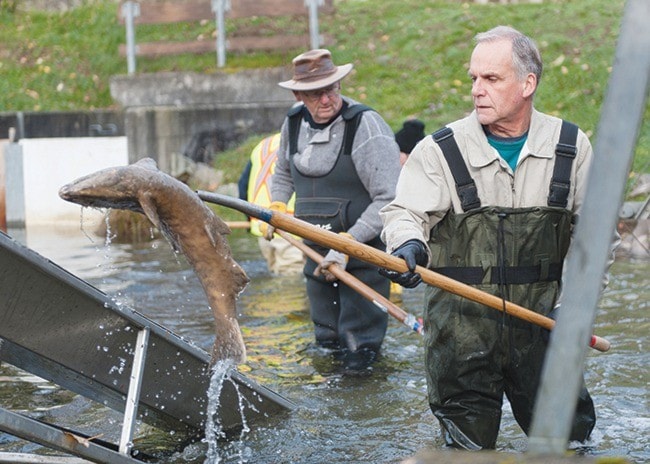The thousands of spawned-out salmon in the channels off Little Qualicum Hatchery may have escaped the backyard grill, but they're still providing meals.
About 20 volunteers from the Qualicum Beach Streamkeepers' Society returned to the hatchery this week for their annual Salmon Toss, a collection and relocation of chum salmon carcasses to the upper reaches of the river system.
"We're creating more food for fish of all types, upriver," said David James, Streamkeepers president. "We're going up five and 10 kilometres to areas the fish don't normally go, so we're extending the fish habitat by doing this.
"Fisheries and Oceans tells us this is one of the best things you can do if you want to improve habitat in salmon streams."
Working in four shifts over two days, Monday and Tuesday, the volunteers used short pikes to gather dead and dying chum in blocked portions of the hatchery spawning channel. The fish, a sickly greyish khaki colour, were loaded onto a conveyor that carried them up the bank and into a pair of totes in the back of a truck rented with funding from Fisheries and Oceans Canada (DFO).
"The Qualicum Beach Streamkeepers have got this down to a fine art now," said Dave Davies, regional community advisor for DFO. "I'm here assisting them with this salmon toss because it follows within DFO's mandate of improving fish habitat in general."
Once the totes were filled, a group of four volunteers drove them upstream and literally tossed the fish, again employing the pikes, into the waters of the Little Qualicum.
Each tote held 125 fish per load, for a total trip of 250 fish. There were two trips each morning and two trips each afternoon by rotating teams of volunteers, meaning a total of 2,000 chum carcasses were tossed, by hand.
“The average weight is 10 to 15 pounds, so we’re putting more than 10 tons of fish nutrients back into the system,” said James. “This year about 35,000 chums came up into the (hatchery) system, so we’re taking a small percentage. The rest will just wash back down the channel and out to sea.”
The salmon toss is just one of the many projects undertaken by Qualicum Beach Streamkeepers and similar organizations working the Englishman River, Nile Creek, French Creek and other mid-Island streams.
“These are all volunteers who find it interesting to work like this out in the forest, helping with all kinds of projects,” James said. “It might be building new spawning pools, taking out barriers where logs have fallen and blocked a salmon-bearing stream, and sometimes we plant trees in areas which have been denuded, to try to stabilize the banks.”
Funding is through donations or occasional, project-specific grants. James said the Pacific Salmon Foundation and the highway department have funded Streamkeepers projects related to salmonid enhancement or stream improvement, and DFO chipped in money for the salmon toss.
“It’s all part of the salmon enhancement program with Fisheries and Oceans,” said Davies. “We’re all trying to achieve the same thing. I sort of facilitate this activity, if it fits in our mandate.”
That mandate includes preserving and enhancing salmon productivity in B.C. streams. Which, Davies said, means improving the salmon’s habitat. And nothing is better at the job than the salmon themselves.
“The bodies rot in the stream and feed bugs and algae, which feed the little fish,” he said. “It also feeds the bears, the otters, the martens and the birds.”
Davies added that researchers have also found that salmon swimming upstream to spawn carry with them nutrients, including specific types of nitrogen and phosphorus, found only in the ocean.
“Researchers have taken core samples of trees along salmon streams and found this particular type of nitrogen and phosphorus in those trees,” he said. “It’s all part of the productivity salmon bring to a stream as they come to spawn.
“Their dead bodies feed the whole watershed.”
